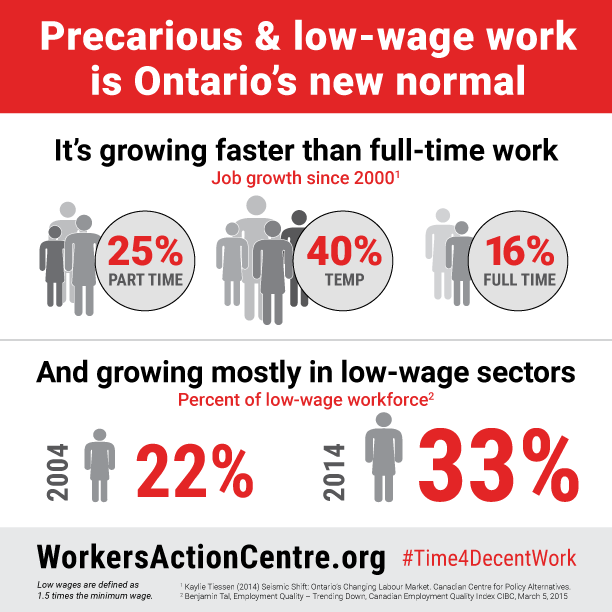There has been a dramatic increase in recent years in precarious work in the Canadian job market. Precarious work is commonly defined as unprotected, non-standard employment that pays poorly, and makes it difficult to support a household. This week’s infographic, published by the Workers' Action Centre, takes a look at the growth of precarious and low-wage work in Ontario in recent years.
The infographic states that precarious and low-wage work has become Ontario’s new normal. According to a CCPA report on Ontario’s changing labour market, part-time jobs have shown 25% job growth since 2010 and temporary jobs have shown 40% job growth. Temporary employment, by its very nature, often results in incomes that are unpredictable, making households more prone to suffering from fluctuations in income. Furthermore, precarious work is growing mostly in low-wage sectors: the percentage of low-wage workforce has increased by 11% in the last ten years.
A common stereotype that is held by Canadians is the belief that many individuals live in poverty and homelessness because they choose to be unemployed. The reality is that high-quality, full-time jobs are becoming increasingly scarce, and that precarious work often fails to even put families over the poverty line. In fact, according to a recent Citizen’s for Public Justice Report, 44% of poor households in Canada had at least one person working in 2011: a job on its own does not guarantee freedom from poverty.
Addressing Precarious Employment
This increase in precarious work has commonly been attributed to restructuring of employment relationships that prioritize productivity over the health and well-being of workers. However, by enacting policies that emphasizes the rights of workers and the need for livable wages, governments can be active participants in supporting the economic health and well-being of its citizens. For this reason, provincial governments across Canada are being asked to increase their minimum wages, so that they become living wages. The term living wages is used to refer to wages that are high enough to maintain and normal standard of living.
As more temporary and part-time employment continues to replace full-time positions, the role of collective representation, including labour union, could play a part in the movement towards change. Compared to non-union members, union members are more likely to receive benefits, wage increases, and opportunities to voice their concerns to management. Unions also help bridge the income divide that exist along the lines of gender and race in non-unionized workplaces. Important thing to consider, is that women and racialized individuals are more likely to live in poverty. Canadian women in unionized workplaces earned, on average, $6.89 more than non-union women in 2013. The earning gap between racialized workers and white workers decreases from an estimated 30% in non-unionized workplaces to 8% in unionized workplaces. Unions achieve these outcomes partially due to collective bargaining. Collective bargaining helps to level the playing field between employees and employers and provides members with representation in the decision-making process.
The continued dissemination and knowledge mobilization of research surrounding existing employment precarity can pave the way for public support for changes in policy and practice. Advocacy and growing public support for the adoption of strategies that address precarious employment is a step towards change.


